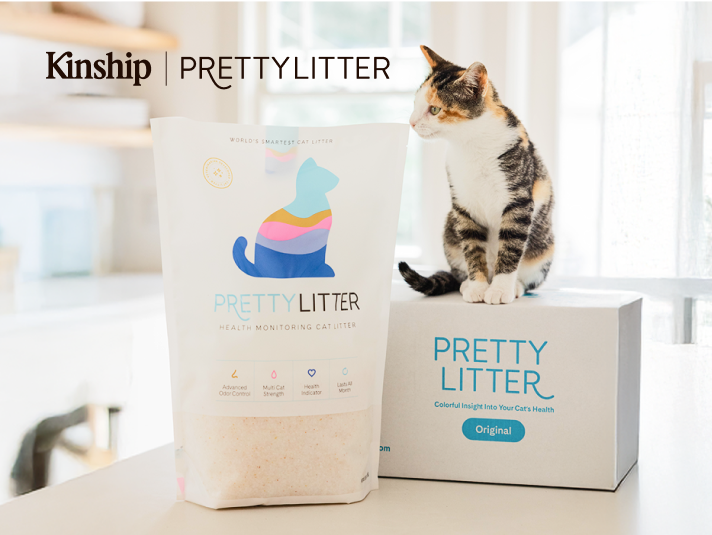Paws apart: Navigating pet co-parenting
From pet-nups to pet custody.
Relationships can be tricky enough to navigate — add a pet to the mix, and there are even more responsibilities, emotions, and decisions to juggle. With more young people choosing to adopt pets and fewer choosing to have human children, the challenges and rewards of co-parenting pets are more relevant than ever before.
In a survey of over 2,000 pet parents, Kinship discovered exciting new findings about how pet co-parenting is working for Americans in all stages of their relationships — from formal pet-nups (yes, that’s a thing) to daily responsibilities to post-break-up pet custody. The stats below break down how Americans across states and cities approach co-pet-parenting, exploring generational differences in pet care planning, legal custody considerations, financial agreements, and other key co-parenting trends.
Save on the litter with color-changing tech that helps you better care for your cat.
Key findings
Gen Z is most likely to have a pet-nup in place (35%).
Three in five Americans would pursue legal action against their partner for pet custody in the event of a breakup.
Splitting up in NYC? Expect to pay your ex an average $125 a month for shared custody of your pup.
Over two in five perceive emotional stress from continued interaction with their ex-partner as the biggest challenge to a pet-nup.
The top conversations before adopting a pet by state
Daily responsibilities, training, financial concerns—there are a lot of important subjects to discuss before bringing home a pet, and people around the country are showing different priorities. We mapped the top conversations people are having before adopting a pet in each state.
Top Conversations Before Adopting A Pet By State map:
https://flo.uri.sh/visualisation/24271441/embedopens in new tab
Most states agree that daily responsibilities are the most important conversation topic. But not all: In Alaska, Nevada, North Dakota, Minnesota, Kentucky, Tennessee, Vermont, Massachusetts, and Delaware, ongoing financial responsibilities win out. In Arkansas, Mississippi, and Hawaii, training considerations are the top training topic. Idaho stands alone as the only state where people rank daily scheduling as their top priority, and Montana is the only state that ranked exercise and activity needs first.
Overall, 60% of pet parents agree that the most important thing to discuss before bringing home a pet is daily responsibilities. Finances are close behind, with 50% think ongoing financial responsibilities is the most important conversation. 41% choose training and discipline approach, 37% choose daily schedule, and 35% choose backup care.
Nearly 3 in 10 pet parents say discussions about emergency funds are essential conversations before pet adoption. Fun fact: Women are 13% more likely than men to opt for discussions about daily responsibilities before adopting a pet.
Top states for pet-nups
Pet-nups — like pre-nups, but for pet parenting — are becoming more and more common as people plan ahead for their pet’s care. We mapped the percentage of pet parents in each state who have or are considering getting a pet-nup agreement.
Top States For Pet-Nups map:
https://flo.uri.sh/visualisation/24271692/embedopens in new tab
Over 24% of surveyed pet parents say they have a pet-nup, and another 22% are considering getting one. Pet-nups are most popular in New York, where an impressive 77% of pet parents have one. On the other side of the coin, in Alaska and Montana, 0% of pet parents have co-parenting agreements. Married couples are 100% more likely than unmarried ones to have a formal pet co-parenting agreement in place.
Co-parenting agreements are more popular across different generations — and it looks like young people are leading the charge. Gen Z are most likely to have pet-nups (35%), followed by millennials (26%), gen X-ers (17%), and baby boomers (10%).
The growing demand for pet custody agreements
Pet-nups are growing in popularity for a good reason. Kinship found that many pet parents would be willing to take legal action for pet custody after a break-up.
Graphic
Women are more likely (63%) than men (56%) to consider pursuing legal action after a breakup. Young people are more likely than older generations; 74% of Gen Z-ers would pursue legal action against an ex for pet custody after a break-up compared to 62% of millennials, 55% of Gen X, and 42% of baby boomers. Cat people (67%) are slightly more likely to pursue legal action than dog people (63%).
Americans’ top perceived pet-nup benefits are that pet-nups ensure a pet’s wellbeing and consistent care (67%), provide clarity on pet custody (65%), and prevent pets from being rehomed or sent to a shelter (56%). Others find that pet-nups reduce emotional stress (53%), offer legal protection for a pet’s future (49%), establish clear financial responsibilities for pet expenses (47%), allow for visitations or shared care (41%), and help make pet decisions proactively (41%).
Essential pet co-parenting conversations
Co-parenting a pet takes communication — and lots of it. Kinship found there are a variety of conversations pet parents tend to have in order to handle the responsibility together.
Graphic
The most common pet care conversation for people co-parenting pets is who would have primary custody of the pet (58%). Finances are next, with the second most common question being how pet-related expenses would be split (48%). How to communicate about a pet’s wellbeing and care is another significant conversation (46%), followed by who would make health and wellness decisions about the pet (45%), what would happen if neither partner could keep the pet (42%), arrangements for visitation or shared care if one partner has primary custody (41%), a plan for resolving future disagreements about the pet (38%), and a plan for a pet’s emotional wellbeing during and after a separation (34%).
When it comes to generational differences, Gen Z is most likely to discuss pet custody in the event of a breakup, with 53% of Gen Z pet parents doing so. Millennials are next at 42%, Gen X comes in at 31%, and only 22% of baby boomers have discussed pet custody. Cat parents are 9% more likely than dog parents to have discussions about their pet’s care in the event of a break-up, and married couples are 27% more likely than unmarried couples to discuss who would make health and medical decisions for their pet after a split.
How much does your half of fido’s care cost? By state
Just like pre-nups between humans, pet-nups impact pet parents’ wallets. How much you can expect to pay your partner monthly varies by state.
Co-Owner Cost Of Pet Care By State map:
https://flo.uri.sh/visualisation/24271862/embedopens in new tab
If you’re splitting up in Hawaii, you can expect to pay your partner at least $125 a month to co-parent your dog. The numbers vary, though, and some states are slightly less expensive — Nebraskans only expect to pay $60 per month.
These numbers aren’t hard rules and likely fluctuate depending on the individual pet in question. How much you pay for your pet’s care will depend on their breed, size, age, and individual care needs.
The greatest perceived challenges of shared pet custody
Break-ups are no picnic, and adding a pet to the mix doesn’t make it easier. People perceive a variety of challenges when it comes to sharing pet custody.
GRAPHIC
Nearly half of pet parents envision an equal split in pet custody after a breakup. The greatest perceived challenge of sharing custody is emotional stress from continued interaction with a pet parent (41%). The second great perceived challenge is disagreements over financial expenses (35%). Other concerns include inconsistency in schedule for the pet between households (34%), communication difficulties between exes (34%), logistical challenges (32%), differing opinions on pet care (32%), inconsistency in training between households (30%), and impact of new partners or family members on the arrangement (30%).
For Gen Z, the emotional stress of seeing an ex is the biggest burden (46%). In general, unmarried couples are 22% more likely than married couples to cite concerns about communication as the greatest perceived challenge. Even with these concerns, nearly half of pet parents have or are considering co-parenting agreements for the wellbeing of the pet.
Conclusion
Attitudes toward co-pet-parenting are evolving across the country, and it has never been clearer that raising a pet together isn’t something to take lightly. From the 24% of pet parents who already have a pet-nup to the growing number of Gen Z couples discussing pet custody before even bringing an animal home, it’s evident that people are planning ahead — and young people are most of all. Whether it’s sorting out daily routines, sharing costs, or managing emotional dynamics, today’s pet parents are setting a new standard for what responsible pet parenting looks like.
Methodology
To explore pet co-parenting agreements, we surveyed 2,088 pet owners living with a significant other. Of the respondents, 78% identified as dog parents, while 69% identified as cat parents. This sample size provides a 95% confidence level with a margin of error of 2%. Because this exploratory research relied on self-reported data, respondents may have biases, and discrepancies may exist between their answers and their actual experiences.
Fair use statement
Have these study findings left you curious about how Americans are handling pet co-parenting, or are you surprised by the rise in pet pre-nups? We invite you to explore and share our findings! All we ask is that you link back to this study to ensure proper attribution to our researchers.

